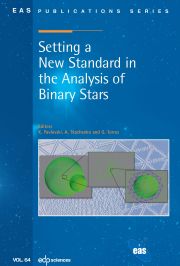Article contents
Temporal Decomposition Studies of GRBLightcurves
Published online by Cambridge University Press: 22 July 2013
Abstract
Gamma-ray bursts (GRB) are extremely energetic events and produce highly diverse lightcurves. Light curves are believed to be resulting from internal shocks reflecting theactivities of the GRB central engine. Hence their temporal studies can potentially lead tothe understanding of the GRB central engine and its evolution. The light curve variabilitytime scale is an interesting parameter which most models attribute to a physical origine.g., central engine activity, clumpy circum-burst medium, orrelativistic turbulence. We develop a statistical method to estimate the GRB minimumvariability time scale (MVT) for long and short GRBs detected by GBM. We find that the MVTof short bursts is distinctly shorter than that for long GRBs supporting the possibilityof a more compact central engine of the former. We find that MVT estimated by this methodis consistent with the shortest rise time of the fitted pulses. Hence we use the fittedpulse rise times to study the evolution of burst variability time scale. Variability timeis in turn related to the minimum bulk Lorentz factor. Using this we relate the GRBspectral evolution to the evolution of the variability time scale.
- Type
- Research Article
- Information
- Copyright
- © EAS, EDP Sciences 2013
References
- 2
- Cited by


